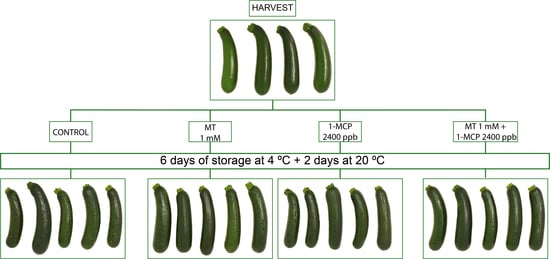A Synergistic Effect Based on the Combination of Melatonin with 1-Methylcyclopropene as a New Strategy to Increase Chilling Tolerance and General Quality in Zucchini Fruit
Abstract
1. Introduction
2. Materials and Methods
2.1. Plant Material and Postharvest Treatments
2.2. Postharvest Quality Parameters
2.3. Statistical Analysis
3. Results and Discussion
3.1. Effect of Exogenous MT and 1-MCP on Weight Loss, Fruit Firmness and Cold Tolerance
3.2. Effect of Exogenous MT and 1-MCP on Respiration Rate and Ethylene Production
3.3. Effect of Exogenous MT and 1-MCP on Membrane Permeability (MDA Content and EL)
3.4. Effect of Exogenous MT and 1-MCP on Chlorophyll Content and External Colour
3.5. Effect of Exogenous MT and 1-MCP on TSS and TA
4. Conclusions
Author Contributions
Funding
Institutional Review Board Statement
Informed Consent Statement
Data Availability Statement
Conflicts of Interest
References
- Wang, C.Y. Combined Treatment of Heat Shock and Low Temperature Conditioning Reduces Postharvest Chilling Injury in Zucchini Squash. Postharvest Biol. Technol. 1994, 4, 65–73. [Google Scholar] [CrossRef]
- Carvajal, F.; Palma, F.; Jamilena, M.; Garrido, D. Cell wall metabolism and chilling injury during postharvest cold storage in zucchini fruit. Postharvest Biol. Technol. 2015, 108, 68–77. [Google Scholar] [CrossRef]
- Bokhary, S.U.F.; Wang, L.; Zheng, Y.; Jin, P. Pre-storage hot water treatment enhances chilling tolerance of zucchini (Cucurbita pepo L.) squash by regulating arginine metabolism. Postharvest Biol. Technol. 2020, 166, 1112–1129. [Google Scholar] [CrossRef]
- Zuo, X.; Cao, S.; Jia, W.; Zhao, Z.; Jin, P.; Zheng, Y. Near-saturated relative humidity alleviates chilling injury in zucchini fruit through its regulation of antioxidant response and energy metabolism. Food Chem. 2021, 351, 129336. [Google Scholar] [CrossRef] [PubMed]
- Zuo, X.; Cao, S.; Zhang, M.; Cheng, Z.; Cao, T.; Jin, P.; Zheng, Y. High relative humidity (HRH) storage alleviates chilling injury of zucchini fruit by promoting the accumulation of proline and ABA. Postharvest Biol. Technol. 2021, 171, 111344. [Google Scholar] [CrossRef]
- Mencarelli, F. Effect of high CO2 atmospheres on stored zucchini squash. J. Am. Soc. Hortic. Sci. 1987, 112, 985–988. [Google Scholar] [CrossRef]
- Serrano, M.; Pretel, M.T.; Martinez-Madrid, M.C.; Romojaro, F.; Riquelme, F. CO2 treatment of zucchini squash reduces chilling-induced physiological changes. J. Agric. Food Chem. 1998, 46, 2465–2468. [Google Scholar] [CrossRef]
- Megías, Z.; Martínez, C.; Manzano, S.; García, A.; Rebolloso-Fuentes, M.M.; Garrido, D.; Valenzuela, J.L.; Jamilena, M. Individual shrink wrapping of zucchini fruit improves postharvest chilling tolerance associated with a reduction in ethylene production and oxidative stress metabolites. PLoS ONE 2015, 10, e0133058. [Google Scholar] [CrossRef]
- Jiménez-Muñoz, R.; Palma, F.; Carvajal, F.; Castro-Cegrí, A.; Pulido, A.; Jamilena, M.; Romero-Puertas, M.C.; Garrido, D. Pre-storage nitric oxide treatment enhances chilling tolerance of zucchini fruit (Cucurbita pepo L.) by S-nitrosylation of proteins and modulation of the antioxidant response, Postharvest. Biol. Technol. 2021, 171, 111345. [Google Scholar] [CrossRef]
- Megías, Z.; Martinez, C.; Manzano, S.; García, A.; Rebolloso-Fuentes, M.M.; Valenzuela, J.L.; Garrido, D.; Jamilena, M. Ethylene biosynthesis and signaling elements involved in chilling injury and other postharvest quality traits in the non-climacteric fruit of zucchini (Cucurbita pepo). Postharvest Biol. Technol. 2016, 113, 48–57. [Google Scholar] [CrossRef]
- Palma, F.; Carvajal, F.; Jiménez-Muñoz, R.; Pulido, A.; Jamilena, M.; Garrido, D. Exogenous γ-aminobutyric acid treatment improves the cold tolerance of zucchini fruit during postharvest storage. Plant Physiol. Biochem. 2019, 136, 188–195. [Google Scholar] [CrossRef] [PubMed]
- Yao, W.; Xu, T.; Farooq, U.; Jin, P.; Zheng, Y. Glycine betaine treatment alleviates chilling injury in zucchini fruit (Cucurbita pepo L.) by modulating antioxidant enzymes and membrane fatty acid metabolism. Postharvest Biol. Technol. 2018, 144, 20–28. [Google Scholar] [CrossRef]
- Martínez-Téllez, M.Á.; Ramos-Clamont, M.G.; Gardea, A.A.; Vargas-Arispuro, I. Effect of infiltrated polyamines on polygalacturonase activity and chilling injury responses in zucchini squash (Cucurbita pepo L.). Biochem. Biophys. Res. Commun. 2002, 295, 98–101. [Google Scholar] [CrossRef]
- Palma, F.; Carvajal, F.; Ramos, J.M.; Jamilena, M.; Garrido, D. Effect of putrescine application on maintenance of zucchini fruit quality during cold storage: Contribution of GABA shunt and other related nitrogen metabolites. Postharvest Biol. Technol. 2015, 99, 131–140. [Google Scholar] [CrossRef]
- Palma, F.; Carvajal, F.; Jamilena, M.; Garrido, D. Putrescine treatment increases the antioxidant response and carbohydrate content in zucchini fruit stored at low temperature. Postharvest Biol. Technol. 2016, 118, 68–70. [Google Scholar] [CrossRef]
- Wang, C.Y.; Buta, J.G. Methyl jasmonate improves quality of stored zucchini squash. J. Food Qual. 1999, 22, 663–670. [Google Scholar] [CrossRef][Green Version]
- Aghdam, M.S.; Fard, J.R. Melatonin treatment attenuates postharvest decay and maintains nutritional quality of strawberry fruits (Fragaria x anannasa cv. Selva) by enhancing GABA shunt activity. Food Chem. 2017, 221, 1650–1657. [Google Scholar] [CrossRef]
- Molla, S.M.; Rastegar, S.; Omran, V.G.; Khademi, O. Ameliorative effect of melatonin against storage chilling injury in pomegranate husk and arils through promoting the antioxidant system. Sci. Hortic. 2022, 295, 110889. [Google Scholar] [CrossRef]
- Cao, S.; Shao, J.; Shi, L.; Xu, L.; Shen, Z.; Chen, W.; Yang, Z. Melatonin increases chilling tolerance in postharvest peach fruit by alleviating oxidative damage. Sci. Rep. 2018, 8, 806. [Google Scholar] [CrossRef]
- Jannatizadeh, A.; Aghdam, M.S.; Luo, Z.; Razavi, F. Impact of Exogenous Melatonin Application on Chilling Injury in Tomato Fruits During Cold Storage. Food Bioprocess Tech. 2019, 12, 741–750. [Google Scholar] [CrossRef]
- Medina-Santamarina, J.; Zapata, P.J.; Valverde, J.M.; Valero, D.; Serrano, M.; Guillén, F. Melatonin treatment of apricot trees leads to maintenance of fruit quality attributes during storage at chilling and non-chilling temperatures. Agronomy 2021, 11, 917. [Google Scholar] [CrossRef]
- Mohammadi, M.; Aelaei, M.; Saidi, M. Pre-harvest and pulse treatments of spermine, γ-and β-aminobutyric acid increased antioxidant activities and extended the vase life of gerbera cut flowers ‘Stanza’. Ornam. Hortic. 2020, 26, 306–316. [Google Scholar] [CrossRef]
- Gao, H.; Lu, Z.; Yang, Y.; Wang, D.; Yang, Y.; Cao, M.; Cao, W. Melatonin treatment reduces chilling injury in peach fruit through its regulation of membrane fatty acid contents and phenolic metabolism. Food Chem. 2018, 245, 659–666. [Google Scholar] [CrossRef]
- Zhang, W.; Jiang, H.; Zhang, Y.; Cao, J.; Jiang, W. Synergistic effects of 1-MCP and hot air treatments on delaying softening and promoting anthocyanin biosynthesis in nectarines. Postharvest Biol. Technol. 2021, 180, 111598. [Google Scholar] [CrossRef]
- Du, Y.; Jin, T.; Zhao, H.; Han, C.; Sun, F.; Chen, Q.; Yue, F.; Luo, Z.; Fu, M. Synergistic inhibitory effect of 1-methylcyclopropene (1-MCP) and chlorine dioxide (ClO2) treatment on chlorophyll degradation of green pepper fruit during storage. Postharvest Biol. Technol. 2021, 171, 111363. [Google Scholar] [CrossRef]
- Aguayo, E.; Jansasithorn, R.; Kader, A.A. Combined effects of 1-methylcyclopropene, calcium chloride dip, and/or atmospheric modification on quality changes in fresh-cut strawberries. Postharvest Biol. Technol. 2006, 40, 269–278. [Google Scholar] [CrossRef]
- Minh, N.P. Synergistic effect of calcium chloride and 1-Methylcyclopropene on storage of watermelon (Citrullus lanatus). Plant Sci. Today. 2021, 8, 118–122. [Google Scholar] [CrossRef]
- Liu, R.; Gao, H.; Chen, H.; Fang, X.; Wu, W. Synergistic effect of 1-methylcyclopropene and carvacrol on preservation of red pitaya (Hylocereus polyrhizus). Food Chem. 2019, 283, 588–595. [Google Scholar] [CrossRef]
- Min, D.; Li, F.; Zhang, X.; Shu, P.; Cui, X.; Dong, L.; Ren, C.; Meng, D.; Li, J. Effect of methyl salicylate in combination with 1-methylcyclopropene on postharvest quality and decay caused by Botrytis cinerea in tomato fruit. J. Sci. Food Agric. 2018, 98, 3815–3822. [Google Scholar] [CrossRef]
- Guo, S.; Li, T.; Wu, C.; Fan, G.; Wang, H.; Shen, D. Melatonin and 1-methylcyclopropene treatments on delay senescence of apricots during postharvest cold storage by enhancing antioxidant system activity. J. Food Process. Preserv. 2021, 45, e15863. [Google Scholar] [CrossRef]
- Megías, Z.; Martinez, C.; Manzano, S.; Barrera, A.; Rosales, R.; Valenzuela, J.L.; Garrido, D.; Jamilena, M. Cold-induced ethylene in relation to chilling injury and chilling sensitivity in the non-climacteric fruit of zucchini (Cucurbita pepo L.). LWT Food Sci. Technol. 2014, 57, 194–199. [Google Scholar] [CrossRef]
- Martínez-Romero, D.; Serrano, M.; Carbonell, A.; Burgos, F. Riquelme, F.; Valero, D. Effects of postharvest putrescine treatment on extending shelf life and reducing mechanical damage in apricot. J. Food Sci. 2002, 67, 1706–1712. [Google Scholar] [CrossRef]
- Zhang, M.; Liu, W.; Li, C.; Shao, T.; Jiang, X.; Zhao, H.; Ai, W. Postharvest hot water dipping and hot water forced convection treatments alleviate chilling injury for zucchini fruit during cold storage. Sci. Hortic. 2019, 249, 219–227. [Google Scholar] [CrossRef]
- Mao, L.C.; Wang, G.Z.; Zhu, C.G.; Pang, H.Q. Involvement of phospholipase D and lipoxygenase in response to chilling stress in postharvest cucumber fruits. Plant Sci. 2007, 172, 400–405. [Google Scholar] [CrossRef]
- Porra, R.J.; Thompson, W.A.; Kriedemann, P.E. Determination of accurate extinction coefficients and simultaneous equations for assaying chlorophylls a and b extracted with four different solvents: Verification of the concentration of chlorophyll standards by atomic absorption spectroscopy. BBA Bioenergetics 1989, 975, 384–394. [Google Scholar] [CrossRef]
- Lin, T.T.; Pitt, R.E. Rheology of apple and potato tissue as affected by cell turgor pressure. J. Texture Stud. 1986, 17, 291–313. [Google Scholar] [CrossRef]
- Heyes, J.A.; Sealey, D.F. Textural changes during nectarine (Prunus persica) development and ripening. Sci. Hortic. 1996, 65, 49–58. [Google Scholar] [CrossRef]
- Lado, J.; Rodrigo, M.J.; Zacarías, L. Analysis of ethylene biosynthesis and perception during postharvest cold storage of Marsh and Star Ruby grapefruits. Food Sci. Technol. 2014, 21, 537–546. [Google Scholar] [CrossRef]
- Tessmer, M.A.; Appezzato-da-Glória, B.; Kluge, R.A. Evaluation of storage temperatures to astringency ‘Giombo’ persimmon: Storage at 1 °C combined with 1-MCP is recommended to alleviate chilling injury. Sci. Hortic. 2019, 257, 108675. [Google Scholar] [CrossRef]
- Zhang, W.; Zhao, H.; Jiang, H.; Xu, J.; Cao, J.; Jiang, W. Multiple 1-MCP treatment more effectively alleviated postharvest nectarine chilling injury than conventional one-time 1-MCP treatment by regulating ROS and energy metabolism. Food Chem. 2020, 330, 127256. [Google Scholar] [CrossRef]
- Qian, C.; Ji, Z.; Zhu, Q.; Qi, X.; Li, Q.; Yin, J.; Liu, J.; Kan, J.; Zhang, M.; Jin, C.; et al. Effects of 1-MCP on proline, polyamine, and nitric oxide metabolism in postharvest peach fruit under chilling stress. Hortic. Plant J. 2021, 7, 188–196. [Google Scholar] [CrossRef]
- Jayarajan, S.; Sharma, R.R. Melatonin: A blooming biomolecule for postharvest management of perishable fruits and vegetables. Trends Food Sci. Technol. 2021, 116, 318–328. [Google Scholar] [CrossRef]
- Sun, Q.; Zhang, N.; Wang, J.; Zhang, H.; Li, D.; Shi, J.; Li, R.; Weeda, S.; Zhao, B.; Ren, S.; et al. Melatonin promotes ripening and improves quality of tomato fruit during postharvest life. J. Exp. Bot. 2015, 66, 657–668. [Google Scholar] [CrossRef]
- Bal, E. Physicochemical changes in Santa Rosa plum fruit treated with melatonin during cold storage. J. Food Meas. 2019, 13, 1713–1720. [Google Scholar] [CrossRef]
- Zhai, R.; Liu, J.L.; Liu, F.X.; Zhao, Y.X.; Liu, L.L.; Fang, C.; Wang, H.B.; Li, X.Y.; Wang, Z.G.; Ma, F.W.; et al. Melatonin limited ethylene production, softening and reduced physiology disorder in pear (Pyrus communis L.) fruit during senescence. Postharvest Biol. Technol. 2018, 139, 38–46. [Google Scholar] [CrossRef]
- Dan, Y.; Zhang, S.; Zhong, H.; Yi, H.; Sainz, M.B. Novel compounds that enhance agrobacterium-mediated plant transformation by mitigating oxidative stress. Plant Cell Rep. 2015, 34, 291–309. [Google Scholar] [CrossRef] [PubMed]
- Zhang, Y.; Huber, D.J.; Hu, M.; Jiang, G.; Gao, Z.; Xu, X.; Jiang, Y.; Zhang, Z. Delay of postharvest browning in Litchi fruit by melatonin via the enhancing of antioxidative processes and oxidation repair. J. Agric. Food Chem. 2018, 66, 7475–7484. [Google Scholar] [CrossRef]
- Fernández-Trujillo, J.P.; Martínez, J.A. Ultrastructure of the onset of chilling injury in cucumber fruit. J. Appl. Bot. Food Qual. 2012, 80, 100–110. [Google Scholar]
- Hakim, A.; Purvis, A.C.; Mullinix, B.G. Differences in chilling sensitivity of cucumber varieties depends on storage temperature and the physiological dysfunction evaluated. Postharvest Biol. Technol. 1999, 17, 97–104. [Google Scholar] [CrossRef]
- Sharafi, Y.; Aghdam, M.S.; Luo, Z.; Jannatizadeh, A.; Razavi, F.; Fard, J.R.; Farmani, B. Melatonin treatment promotes endogenous melatonin accumulation and triggers GABA shunt pathway activity in tomato fruits during cold storage. Sci. Hortic. 2019, 254, 222–227. [Google Scholar] [CrossRef]
- Shelp, B.J.; Bown, A.W.; McLean, M.D. Metabolism and functions of gamma-aminobutyric acid. Trends Plant Sci. 1999, 4, 1360–1385. [Google Scholar] [CrossRef]
- Kou, X.; Feng, Y.; Yuan, S.; Zhao, X.; Wu, C.; Wang, C.; Xue, Z. Different regulatory mechanisms of plant hormones in the ripening of climacteric and non-climacteric fruits: A review. Plant Mol. Biol. 2021, 107, 477–497. [Google Scholar] [CrossRef] [PubMed]
- Watkins, C.B. The use of 1-methylcyclopropene (1-MCP) on fruits and vegetables. Biotechnol. Adv. 2006, 24, 389–409. [Google Scholar] [CrossRef] [PubMed]
- Bi, X.; Dai, Y.; Zhou, Z.; Xing, Y.; Che, Z. Combining natamycin and 1-methylcyclopropene with modified atmosphere packaging to evaluate plum (Prunus salicina cv. ‘Cuihongli’) quality. Postharvest Biol. Technol. 2022, 183, 111749. [Google Scholar] [CrossRef]
- Cao, S.; Yang, Z.; Zheng, Y. Effect of 1-methylcyclopene on senescence and quality maintenance of green bell pepper fruit during storage at 20 °C. Postharvest Biol. Technol. 2012, 70, 1–6. [Google Scholar] [CrossRef]
- Xu, F.; Liu, S. Control of postharvest quality in blueberry fruit by combined 1-methylcyclopropene (1-MCP) and UV-C irradiation. Food Bioprocess Technol. 2017, 10, 1695–1703. [Google Scholar] [CrossRef]
- Arnao, M.B.; Hernández-Ruiz, J. Melatonin: A New Plant Hormone and/or a Plant Master Regulator? Trends Plant Sci. 2019, 24, 38–48. [Google Scholar] [CrossRef]
- Wang, S.Y.; Shi, X.C.; Wang, R.; Wang, H.L.; Liu, F.; Laborda, P. Melatonin in fruit production and postharvest preservation: A review. Food Chem. 2020, 320, 126642. [Google Scholar] [CrossRef]
- Blanco-Díaz, M.T.; Pérez-Vicente, A.; Font, R. Quality of Fresh Cut Zucchini as Affected by Cultivar, Maturity at Processing and Packaging. Packag. Technol. Sci. 2016, 29, 365–382. [Google Scholar] [CrossRef]
- Khanna-Chopra, R. Leaf senescence and abiotic stresses share reactive oxygen species-mediated chloroplast degradation. Protoplasma 2012, 249, 81–469. [Google Scholar] [CrossRef]
- Wei, L.; Liu, C.; Wang, J.; Younas, S.; Zheng, H.; Zheng, L. Melatonin immersion affects the quality of fresh-cut broccoli (Brassica oleracea L.) during cold storage: Focus on the antioxidant system. J. Food Process. Preserv. 2020, 44, e14691. [Google Scholar] [CrossRef]
- Dong, J.; Kebbeh, M.; Yan, R.; Huan, C.; Jiang, T.; Zheng, X. Melatonin treatment delays ripening in mangoes associated with maintaining the membrane integrity of fruit exocarp during postharvest. Plant Physiol. Biochem. 2021, 169, 22–28. [Google Scholar] [CrossRef] [PubMed]
- Madebo, M.P.; Luo, S.M.; Wang, L.; Zheng, Y.H.; Jin, P. Melatonin treatment induces chilling tolerance by regulating the contents of polyamine, γ-aminobutyric acid, and proline in cucumber fruit. J. Integr. Agric. 2021, 20, 3060–3074. [Google Scholar] [CrossRef]
- Jafari, R.; Zandi, M.; Ganjloo, A. Effect of gelatin–alginate coating containing anise (Pimpinella anisum L.) essential oil on physicochemical and visual properties of zucchini (Cucurbita pepo L.) fruit during storage. J. Food Process. Preserv. 2022, 46, e16756. [Google Scholar] [CrossRef]
- Valero, D.; Serrano, M. Postharvest Biology and Technology for Preserving Fruit Quality; CRC Press/Taylor & Francis: Boca Raton, FL, USA, 2010. [Google Scholar]
- Zeng, W.; Mostafa, S.; Lu, Z.; Jin, B. Melatonin-Mediated Abiotic Stress Tolerance in Plants. Front. Plant Sci. 2022, 13, 847175. [Google Scholar] [CrossRef]
- Boonyaritthongchai, P.; Supapvanich, S. Effects of methyl jasmonate on physicochemical qualities and internal browning of ‘Queen’ pineapple fruit during cold storage. Hortic Environ Biotechnol. 2017, 58, 479–487. [Google Scholar] [CrossRef]
- Sangsoy, K.; Beckles, D.M.; Terdwongworakul, A.; Luengwilai, K. Discriminating pineapple batches for susceptibility to postharvest internal browning. Sci. Hortic. 2022, 300, 111069. [Google Scholar] [CrossRef]
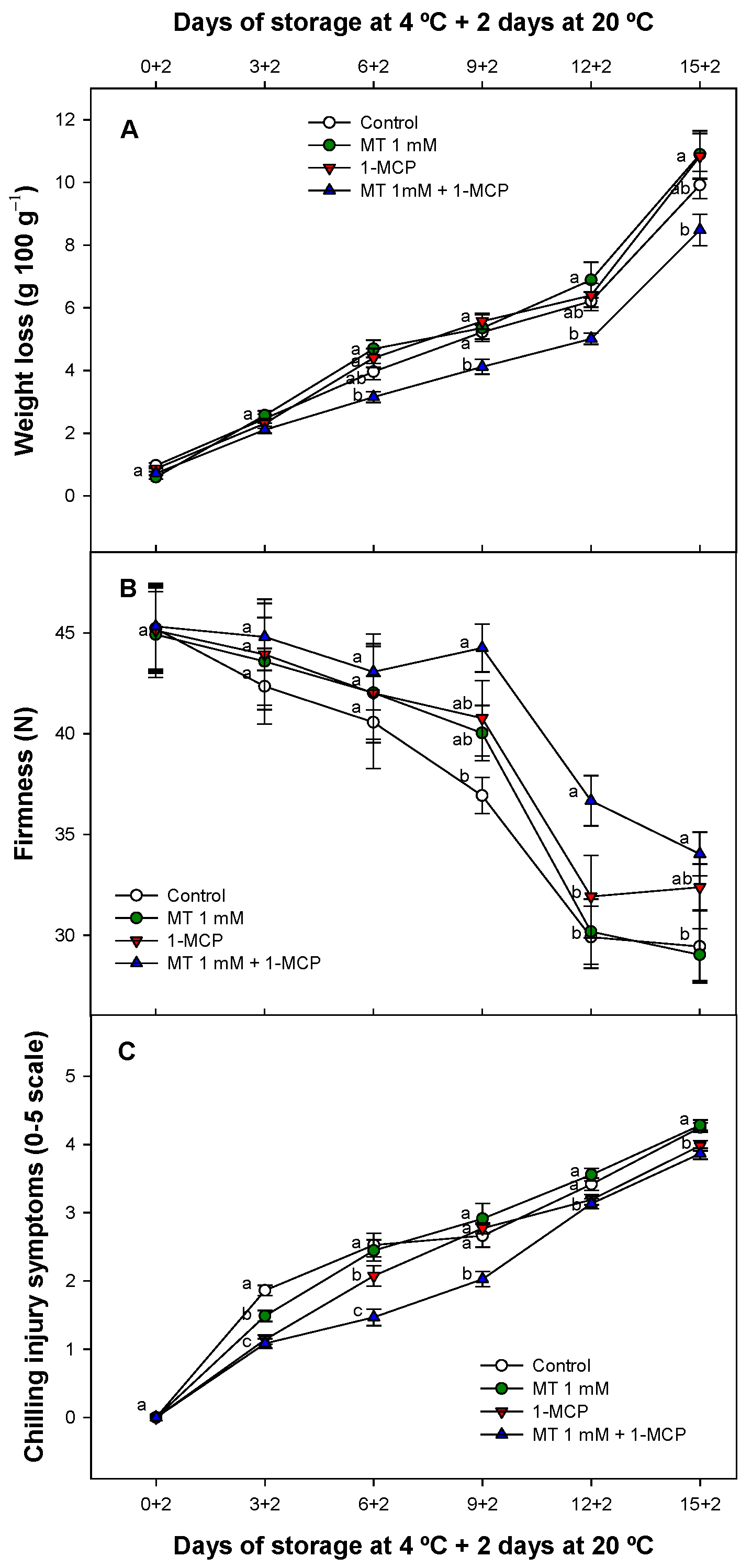
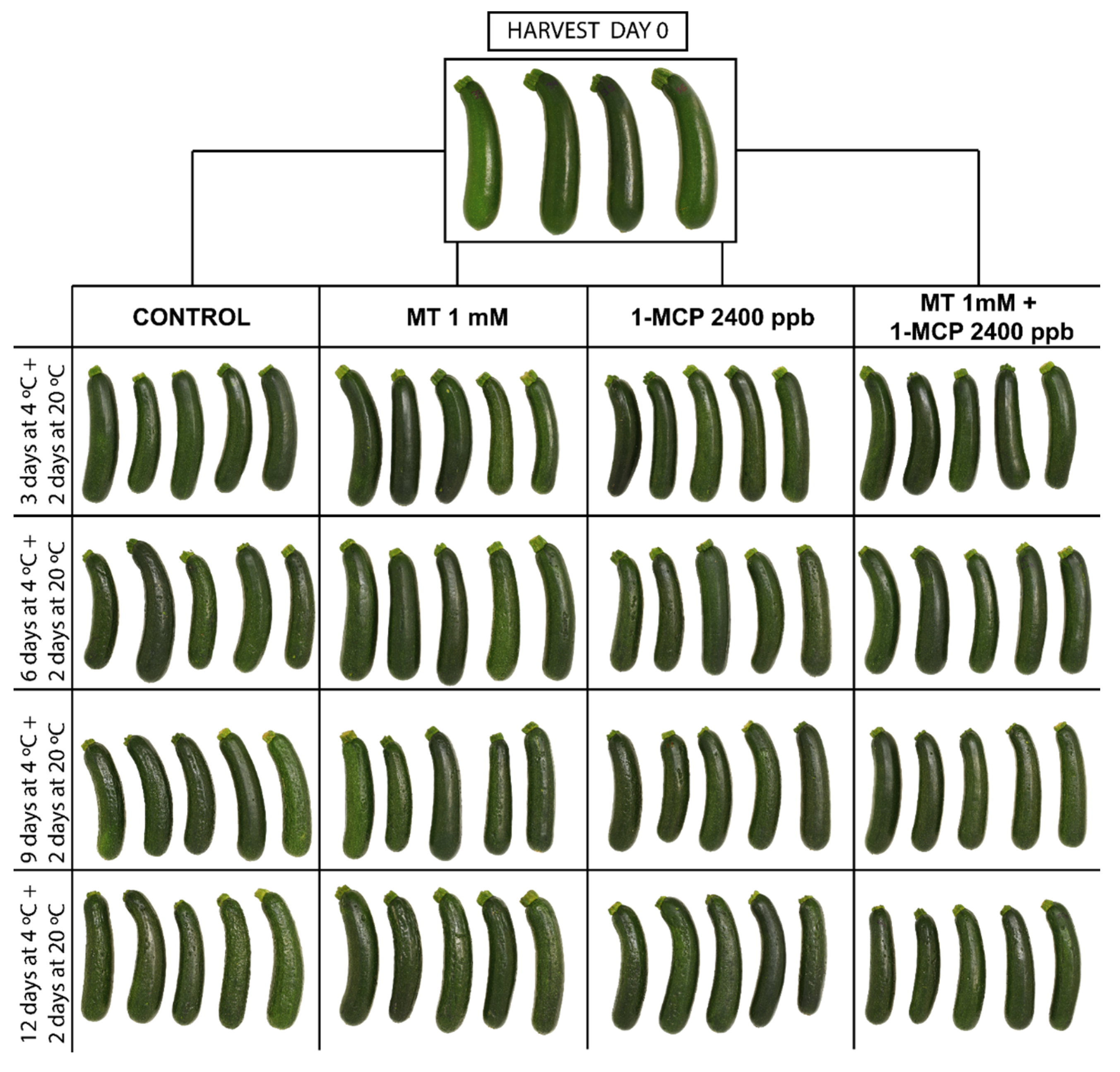
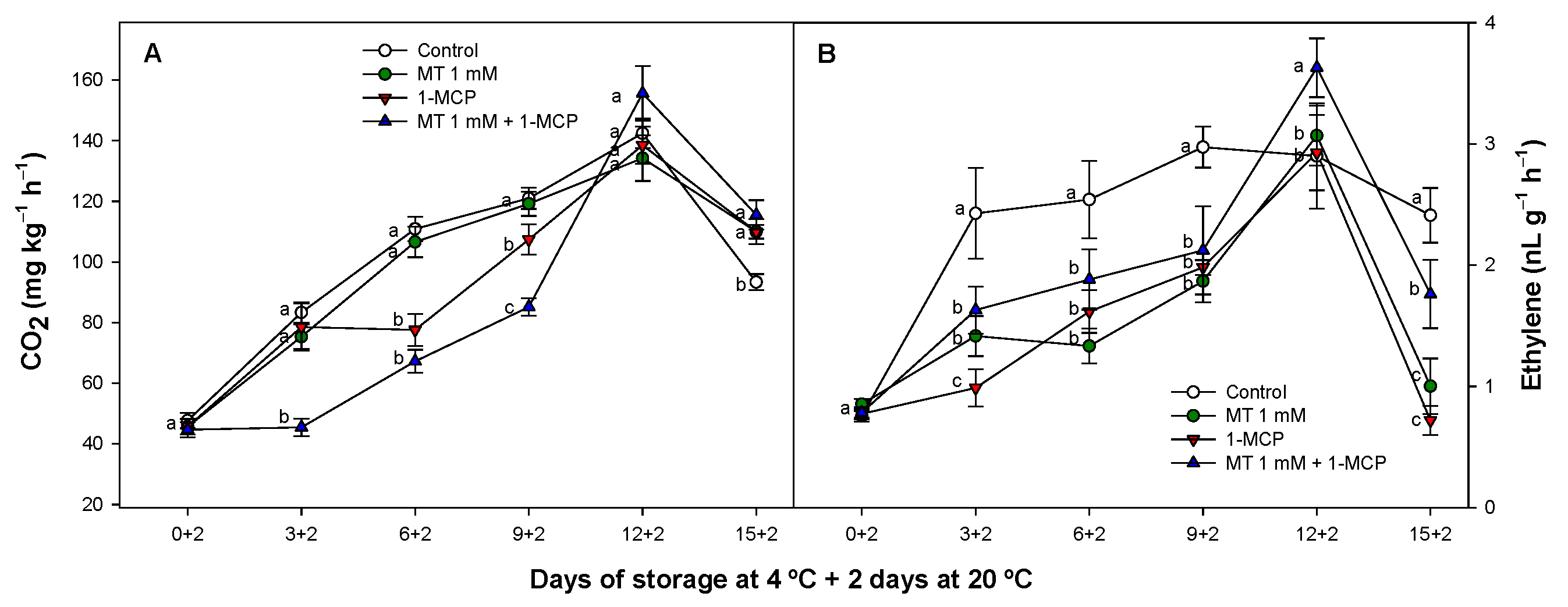
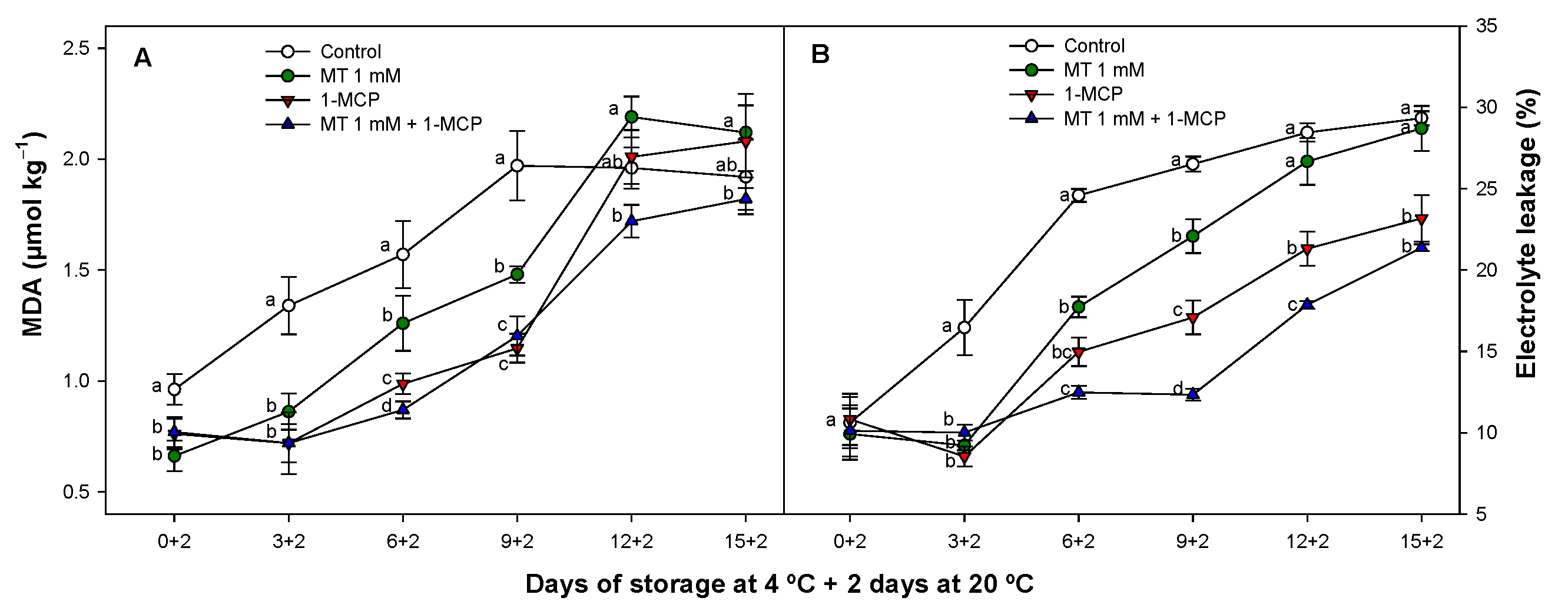
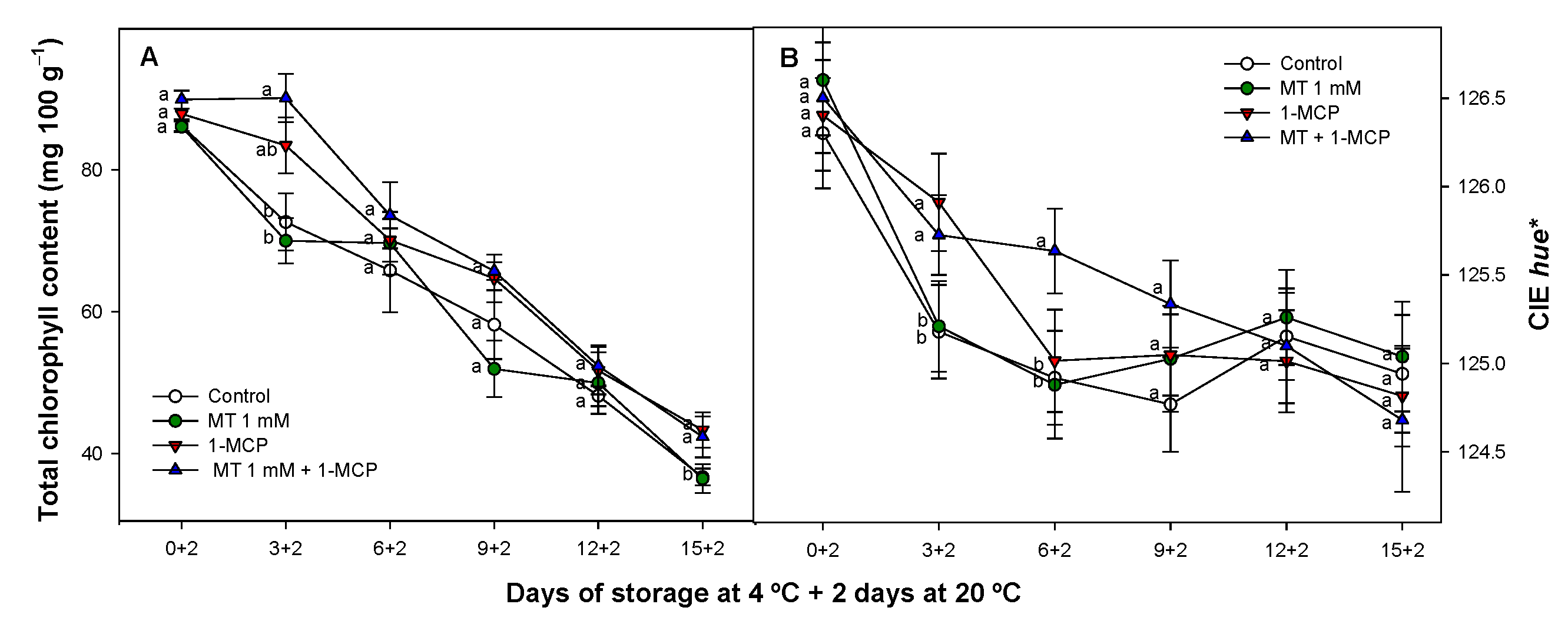
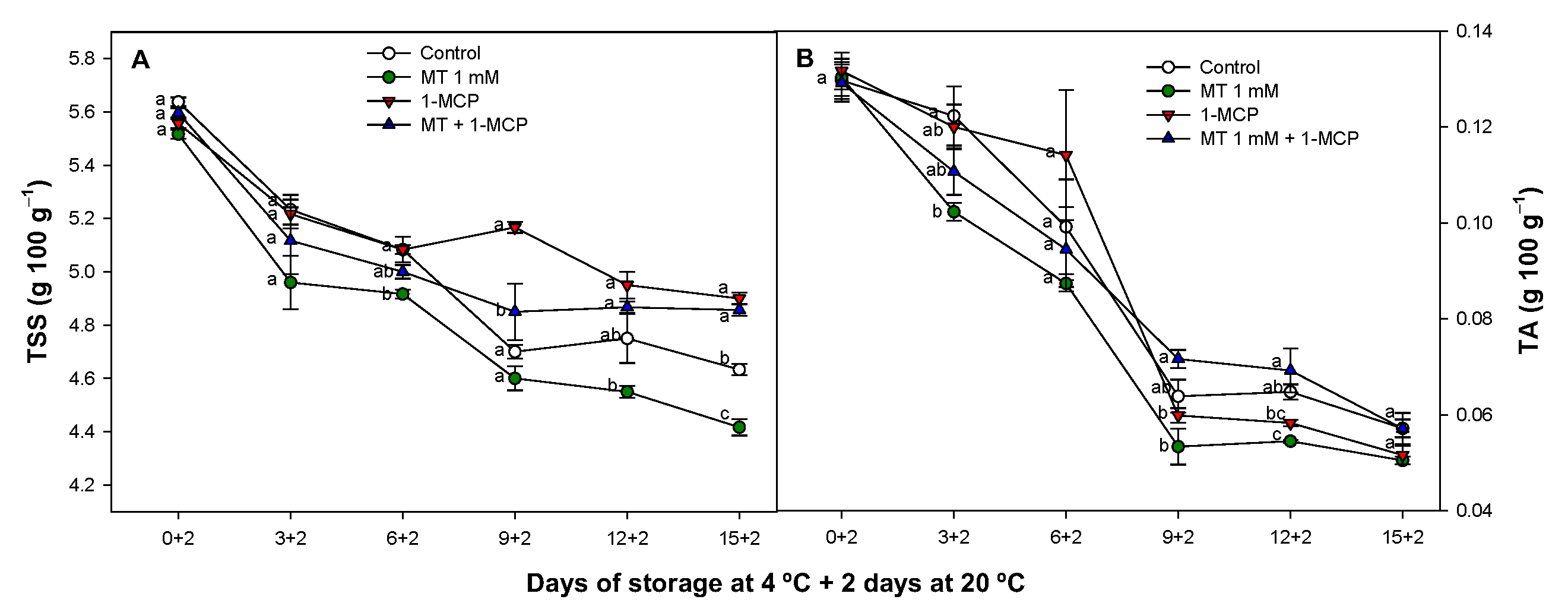
Publisher’s Note: MDPI stays neutral with regard to jurisdictional claims in published maps and institutional affiliations. |
© 2022 by the authors. Licensee MDPI, Basel, Switzerland. This article is an open access article distributed under the terms and conditions of the Creative Commons Attribution (CC BY) license (https://creativecommons.org/licenses/by/4.0/).
Share and Cite
Medina-Santamarina, J.; Serrano, M.; Ruiz-Aracil, M.C.; Ilea, M.I.M.; Martínez-Romero, D.; Guillén, F. A Synergistic Effect Based on the Combination of Melatonin with 1-Methylcyclopropene as a New Strategy to Increase Chilling Tolerance and General Quality in Zucchini Fruit. Foods 2022, 11, 2784. https://doi.org/10.3390/foods11182784
Medina-Santamarina J, Serrano M, Ruiz-Aracil MC, Ilea MIM, Martínez-Romero D, Guillén F. A Synergistic Effect Based on the Combination of Melatonin with 1-Methylcyclopropene as a New Strategy to Increase Chilling Tolerance and General Quality in Zucchini Fruit. Foods. 2022; 11(18):2784. https://doi.org/10.3390/foods11182784
Chicago/Turabian StyleMedina-Santamarina, Jorge, María Serrano, María Celeste Ruiz-Aracil, Mihaela Iasmina Madalina Ilea, Domingo Martínez-Romero, and Fabián Guillén. 2022. "A Synergistic Effect Based on the Combination of Melatonin with 1-Methylcyclopropene as a New Strategy to Increase Chilling Tolerance and General Quality in Zucchini Fruit" Foods 11, no. 18: 2784. https://doi.org/10.3390/foods11182784
APA StyleMedina-Santamarina, J., Serrano, M., Ruiz-Aracil, M. C., Ilea, M. I. M., Martínez-Romero, D., & Guillén, F. (2022). A Synergistic Effect Based on the Combination of Melatonin with 1-Methylcyclopropene as a New Strategy to Increase Chilling Tolerance and General Quality in Zucchini Fruit. Foods, 11(18), 2784. https://doi.org/10.3390/foods11182784








